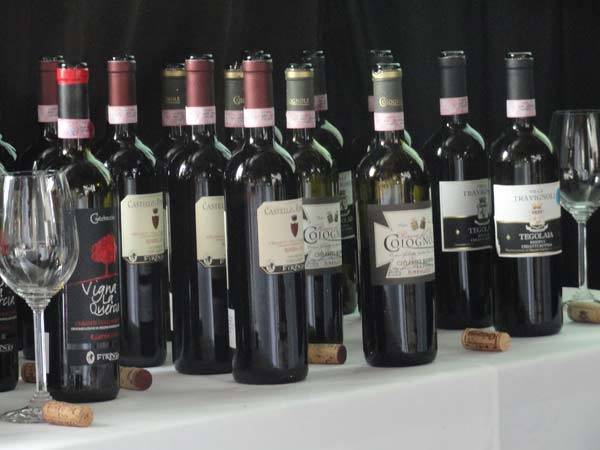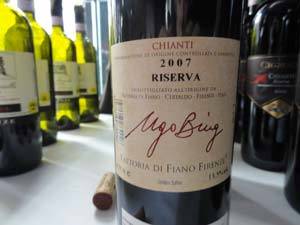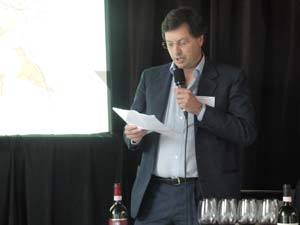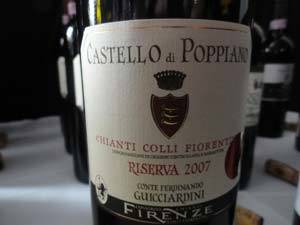Chianti's "New Look"
It seems to me that with the exception of the Chianti Classico sub-zone, Chianti DOCG has an identity crisis. The Chianti Classico sub-zone is the “original” zone between Florence and Siena. It has its own Consortium and since 2005, when the government seal is put on a bottle it includes the Gallo Nero (black rooster) symbol. The Classico Consortium seems to want to distant itself from the rest of Chianti.
The other Chianti sub-zones joined together to a formed their own Consortium, called Il Consorzio Del Chianti Putto. Its symbol was a cherub draped in grapes. I say “was” because IL Consorzio Del Chianti Putto does not exist anymore nor does its symbol.
When I was invited to attend a seminar and tasting by the Consorzio Vino Chianti, I was very interested in attending. How was this “new” Consortium going to promote Chianti and make it less confusing for the consumer? So many sub-zones, so many different grapes, the rules changing too often (adding new sub-zones, changing the grapes that can be used and the percentage of grapes). With 2,650 members in the Consortium, they have a big job in front of them.
The panel for the seminar was made up of Giovanni Busi, president of the Consorzio and owner of the Travignoli winery, Nicola Marzovilla, Giovanni’s importer and translator, Laura De Pasquale from Palm Bay international and wine writer Bill Marsano. The moderator was Robin Kelly O’Connor of Christie’s fine wine auctions.
After the introduction and some background information, Mr. O’Connor asked Mr. Busi to speak about Chianti and the Consorzio. Mr Busi began by speaking about the Chianti sub-zones that were members of the Consortium.
The Chianti production zone consists of areas which are determined by Italian law in the provinces of Arezzo, Florence, Pisa, Pistoia, Prato and Siena. Giovanni said that he viewed the whole area as one large “Chianti Valley” characterized by hills with large terraces and valleys crossed by rivers.
The wine can just have Chianti on the label or have one of the seven designated zones: Colli Aretini, Colli Fiorentini, Colli Senesi, Colli Pisane, Montalbano, Rufina, Montespertoli. In addition there is the Colli Dell’Etruria Centrale as well as the return of the Superiore classification.
The Colli Dell’Etruria Centrale area is everything that has been left out of the other areas and at the same time included in them-I think? The designation is positioned alongside the Chianti DOCG and permits the production in the same area of wines of a different quality from Chianti, with red wines being joined by white, rose, novella and Vin Santo del Chianti.
Chianti can be 70-100% Sangiovese, a maximum of 10 white grapes (Malvasia and Trebbiano) and 15% of authorized red grapes such as Cabernet, Merlot and Syrah.
Chianti Superiore can be produced in all of the Chianti sub-zones with the exception of Chianti Classico. Producers in these other sub-zones can make a Superiore but it cannot have the name of the sub-zone on the label. Superiore means that it has higher quality standards like lower yields and higher alcohol. It can be 75-100% Sangiovese, a max. of 10% Canaiolo, and 20% of other authorized grapes such as Cabernet, Merlot, Syrah etc.
I asked Giovanni if the “new” Consorzio had a symbol and he said that it did not have one and that the old symbol of the Chianti Putto was a thing of the past.
One of the subjects that came up was the blend used to make Chianti. Of the wines we tasted most of the panelists seemed to favor the wines that included native grapes and not international ones. Giovanni went as far as to say that Chianti should be made from 100% Sangiovese. He believes that when the Sangiovese 2000 project was completed they were able to single out the best Sangiovese clones. These clones were better and healthier than those used in the past and therefore Sangiovese did not need to be part of a blend but could stand on its own.
I never understand why Chianti in straw-covered bottles is always mentioned. People seem to believe that 40 years ago Chianti only came in this type of bottle, but this is not true. Recently I had a 1964 Villa Antinori and a 1958 Ruffino Riserva Ducale Gold Label and both were in Bordeaux- type bottles. The Ruffino was not a Chianti Classico --the label just said Chianti. All the Chianti I brought 40 years ago was always in a Bordeaux type bottle.
It was mentioned that Chianti in the past was made using the “governo method” (10% of the grapes, usually Canaiolo, were dried) and because of this it would not age and did not make a good wine. I disagreed. The 1947 and 1958 Ruffino Gold Label were made with the governo method as were a number of other old wines which are still drinking today. One of the reasons it is no longer done was that it was too expensive and “old fashioned”. Giovanni said that the new clones of Sangiovese that they are using now are so much better that there is really no need to use the governo method.
The Wines
All of the wines were Riservas from the 2007 vintage. 2007 was a very good year in Tuscany right after 2001 and 2004. The number of bottles produced by each producer was very low, ranging from 3,000 to 20,000 bottles. If I understood Giovanni correctly the Riserva has to be aged for 18 months, and 6 of the months in wood. The price of the wines because they have the sub-zone on the label and are also Riservas are more expensive than a wine with just Chianti on the label, would be between $20 and $30. The only retail price that we knew was the Travignoli at $28 because the importer was on the panel.
I agreed with the panel that the best wines were those made from with the local grapes. Some of the wines were aged in cement tanks, which might be making a comeback.
Chianti DCOG Riserva 2007- Az.Agr. ACorbinelli
The vineyards are located in the Certaldo/Montespertoli area. The wine is a minimum of 80% Sangiovese and other approved red grapes. Fermentation is on the skin for fifteen days. The wine is aged for 12 months in cement tanks and for three months in bottle before release. For this wine there is no wood aging mentioned and the total aging is 15 months-3 months less than the law allows according to Giovanni. One panel member said that the producer must have left out the three months in wood on the tasting sheet. Is it 3 months in wood or 6 months in wood- this was not made clear to me.
Chianti Colli Fiorentini “Villa Marcialla” DOCG Riserva 2007- Fattorie Giannozza
The vineyards are in Marcialli and the wine is 90% Sangiovese and 10% Merlot. Fermentation takes place for 3/8 days. Maceration for about 15 days is stainless steel tanks. The wine is aged in big oak barrels (botti) for 26 months and 6 months in bottle before release.
Chianti “Ugo Bing” DOCG Riserva 2007- Fattoria di Fiano. The vineyards are in Certaldo, Loc. Fiano and are between 200/300 mt above sea level with a South-East/North-East exposure. The grapes are Sangiovese,Canaiolo, Merlot, Colorino and Syrah. Traditional fermentation with pumping over and delestage - 7/9 days. The wine is aged in 27hl cement vats and barrels.
Chianti “Cignozza” DOCG Riserva 2007- AZ. AGR. La Cignozza di Roberto Del Bruno. Location of Vineyards, Chianciano. 80% Sangiovese and 20% Canaiolo. They only produce Riserva during the best vintages. Fermentation takes place in stainless steel tanks for about 12 days with three pump-overs a day. Because of the density, the pump over is then substituted by the delestage (empting and refilling the tank). The juice is then left to settle in stainless steel tanks. After malolatic fermentation 50% of the wines is aged in tonneaux barrels to mature between January and February and the rest in large oak barrels for 24 months. It remains in the bottle for 5 months and is then released.
Chianti “Vigna La Quercia” Colli Fiorentini DOCG Riserva 2007- AZ. AGR. Castelvecchio. Location of the vineyards San Casciano Val di Pesa. The wine is 90% Sangiovese and 10% Cabernet Sauvignon. Maceration for 48 hours and fermentation at controlled temperature for 15 days. The wine is aged in oak barriques for 12 months and another 12 months in bottle before release.
Chianti Colli Fiorentini DOCG Riserva 2007- Castello di Poppiano Guiccardini.
Location of vineyards, Montespertoli. 75 % Sangiovese, 20% Melo Cabernet and 5% Canaiolo. Fermentation in stainless steel vats and skin contact for 18 days. The wine is aged for 18/24 in oak barrels and three months in bottle before release.
Chianti Rufina “Del Don” DOCG Riserva 2007 - Ag. Agr. Colognole. Location of vineyards Colognole (Pontesieve) 100% Sangiovese. There is skin contact for 12/15 days with frequent punching down. 50% is aged in Slovenian and French oak casks 20-30 hl and the rest in Allier tonneau of 500lt. It is aged 18 months in bottle before release.
Chianti Rufina “Tegolaia” DOCG Riserva 2007- Travignoli Di Conte G. Busi SRL Location of the vineyards, Pelago 100% Sangiovese. Fermentation in stainless steel for 20 days. The wine is aged in oak barrels of 2,500 liters for 18 months and for 8 months in bottle before release.








































i-Italy
Facebook
Google+
This work may not be reproduced, in whole or in part, without prior written permission.
Questo lavoro non può essere riprodotto, in tutto o in parte, senza permesso scritto.